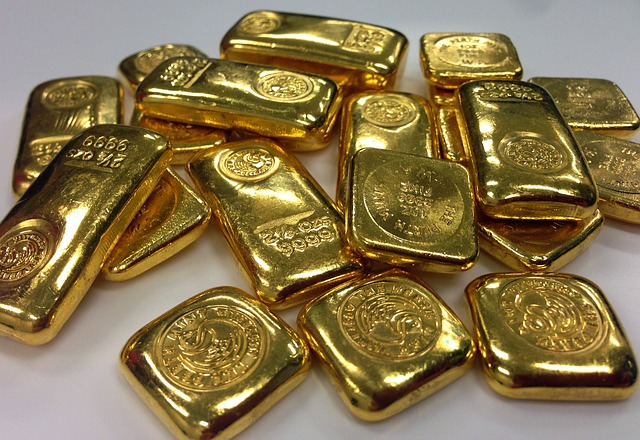The article describes the steps necessary to convert a traditional Roth IRA into one that allows investment in IRS-approved precious metals like gold, silver, platinum, and palladium. It highlights the need for opening a self-directed Roth IRA with a specialized custodian adept at managing alternative investments, ensuring compliance with IRS regulations throughout the process. The conversion can be funded through a direct rollover from an existing Roth IRA or another qualified account. Once the new account is established and funded, investors may purchase eligible precious metals, adhering to the IRS's purity standards and storage guidelines. Research on custodians and dealers is crucial for transparency and security. The process ensures a diversified retirement portfolio with tangible assets, enhancing the tax-advantaged benefits of a Roth IRA. It's important to understand the tax implications of converting traditional IRAs to Roth IRAs for gold investments, as funds converted are immediately subject to income taxes but offer tax-free growth and withdrawals post-retirement if all IRS rules are followed.
Exploring the transformation of a Roth IRA into a gold-backed investment offers a unique opportunity for wealth diversification. This article navigates the step-by-step process of setting up a self-directed Roth IRA tailored for precious metals, including gold. We delve into the IRS guidelines ensuring compliance for such investments, guide you through selecting a trustworthy custodian, and explore the nuances of purchasing eligible gold types. Additionally, we examine the tax implications of this strategic financial move. By understanding these elements, investors can make informed decisions to augment their retirement portfolios with the timeless value of gold.
- Setting Up a Self-Directed Roth IRA for Precious Metals
- IRS Guidelines and Compliance for Gold Investments in Roth IRAs
- Selecting a Trustee and Custodian for Your Gold IRA
- Purchasing Gold: Types and Eligibility Criteria
- Tax Considerations When Converting to a Gold Roth I
Setting Up a Self-Directed Roth IRA for Precious Metals

To initiate the process of converting your Roth IRA to gold or other precious metals, the first step is to set up a self-directed Roth IRA. This account differs from traditional IRAs as it offers the freedom to invest in a wider array of assets, including physical gold, silver, platinum, and palladium coins or bars that meet the standards set by the Internal Revenue Service (IRS). When establishing this type of IRA, it is crucial to select a custodian that specializes in self-directed accounts and is equipped to handle alternative investments like precious metals. These custodians facilitate the transaction process, ensuring compliance with IRS regulations. Once you have chosen a reputable custodian, you will need to fund your new Roth IRA. This can be done through a direct rollover from an existing Roth IRA or another tax-advantaged account, such as a 401(k). After the funds are transferred and your account is established, you may begin the process of purchasing eligible precious metals, adhering to the IRS’s purity and storage requirements. It’s important to conduct thorough research on both the custodian and the precious metals dealer to ensure a transparent and secure investment process. By carefully following these steps, you can effectively set up a self-directed Roth IRA for precious metals, paving the way for a diversified retirement portfolio that includes tangible assets.
IRS Guidelines and Compliance for Gold Investments in Roth IRAs

When considering the conversion of a Roth IRA to gold investments, adherence to Internal Revenue Service (IRS) guidelines is paramount. The IRS stipulates that within a self-directed Roth IRA, you may invest in certain types of precious metals as long as they comply with the purity and custody requirements set forth by the IRS for retirement accounts. These metals must be held in an IRS-approved depository or secured by an IRS-approved custodian to maintain the tax-advantaged status of the Roth IRA. The IRS allows for investments in gold, silver, platinum, and palladium bullion and coins that meet specific fineness criteria; for example, gold must be at least 99.5% pure. It’s crucial to work with a custodian or trustee experienced in rare precious metals to ensure compliance throughout the investment process. Additionally, any transaction involving the purchase or exchange of these metals within your Roth IRA must be conducted through this authorized entity to maintain the integrity of your tax-advantaged investment vehicle. Regularly consulting the latest IRS Publication 590-B for Tax-Exempt Accounts is essential to stay informed about any updates or changes to the rules governing these investments. This due diligence ensures that your Roth IRA remains in good standing and that your gold investments continue to offer the potential benefits associated with a diversified retirement portfolio.
Selecting a Trustee and Custodian for Your Gold IRA

When considering the conversion of your Roth IRA to a gold-backed investment, one of the critical steps is selecting a trustee and custodian for your Gold IRA. The trustee, who is responsible for administering the IRA, must be a bank, trust company, or an individual retirement account (IRA) custodian that is approved by the Internal Revenue Service (IRS). This entity will ensure compliance with IRS rules and regulations, which are paramount in maintaining the tax-advantaged status of your Roth IRA.
The custodian, on the other hand, is the financial institution that holds your assets. For a Gold IRA, this means a custodian that specializes in precious metals and can handle transactions involving gold coins, bars, and other approved investments. It’s essential to choose a custodian with expertise in such assets to guarantee secure storage and accurate record-keeping. The combination of a knowledgeable trustee and a specialized custodian will provide you with the confidence that your investment is both legally sound and strategically positioned within the precious metals market. They will also guide you through the process of purchasing IRS-approved gold, ensuring that it meets the purity standards required for inclusion in your Gold IRA.
Purchasing Gold: Types and Eligibility Criteria

When considering the purchase of gold for your Roth IRA, it’s crucial to understand the types of gold that are eligible for holding within a self-directed Roth IRA. The Internal Revenue Service (IRS) stipulates that the gold must be of a certain purity; specifically, it should be 99.5% pure or better. This purity level is standard for coins and bullion to be included in an IRA. Among the eligible types are American Gold Eagles, Canadian Gold Maple Leafs, and Austrian Philharmonic gold coins, as well as certain gold bars that meet the fineness requirements. Additionally, the gold must be held by a custodian that specializes in precious metals IRAs to ensure compliance with IRS regulations. The eligibility criteria are designed to safeguard the integrity of the investment and protect the financial interests of IRA holders. Investors interested in including gold in their Roth IRA should work closely with both a trusted financial advisor and an IRS-approved custodian to navigate the process effectively and ensure that all investments meet the necessary criteria. This collaboration ensures that your investment strategy aligns with the rules governing retirement accounts, allowing you to diversify your portfolio with physical gold in compliance with regulations.
Tax Considerations When Converting to a Gold Roth I

When considering the conversion of a traditional IRA to a Roth IRA with the intention of investing in gold, it’s crucial to understand the tax implications involved. The Roth IRA, while offering tax-free growth and withdrawals in retirement, subjects the converted funds to taxes at the time of conversion. This means that any amounts transferred from a traditional IRA to a Roth IRA are taxable and must be reported as ordinary income on your federal income tax return for the year of the conversion. However, this one-time tax cost can be beneficial in the long term, as it allows for tax-free growth of your investment in gold and other precious metals within the Roth IRA, assuming you adhere to IRS distribution rules upon reaching retirement age.
Upon establishing a self-directed Roth IRA that permits investments in physical gold and other approved precious metals, investors should be aware of the specific requirements set forth by the Internal Revenue Service (IRS). The IRS dictates that for a Roth IRA to hold gold or other bullion, it must consist of coins or bars that are compliant with IRS purity standards. This ensures that the investment is legitimate and eligible within the framework of your retirement account. Additionally, investors must handle these transactions through a trustee or custodian that specializes in these types of assets to maintain compliance with IRS rules. By carefully considering the tax implications and adhering to the regulations, investors can effectively diversify their retirement portfolio with alternative investments like gold while reaping the potential benefits of a Roth IRA structure.
In conclusion, transitioning your Roth IRA into a gold investment is a process that combines financial planning with the strategic choice of tangible assets. By establishing a self-directed Roth IRA that accommodates precious metals, you gain access to a diverse portfolio that includes gold, beyond the confines of traditional stock and bond markets. It’s crucial to adhere to IRS guidelines to ensure your investment remains compliant. Selecting a reputable trustee and custodian is paramount for the safekeeping and management of your gold holdings. Understanding the tax implications and the types of gold eligible for purchase within a Roth IRA are key steps in this endeavor. With careful consideration and the right guidance, converting your Roth IRA to gold can be a prudent move to diversify and secure your retirement savings.
